Top 5 SEO Trends 2022 that you should know!
Top 5 SEO predictions for 2022: it's time to re-think your content marketing strategy while focusing on continuous innovation and AI.
The year 2021 left most of us disoriented and speechless. Yet, I believe we all realized how important it is to stay connected and build an open and democratic society that can tackle misinformation and disinformation. 2022 will be a year of data empowerment. Now, more than ever, everyone can use artificial intelligence and create a significant impact on both business and society. Yet, this is only possible when organizations own and manage meaningful and well-formed semantic data.
“There is a wealth of content that we produce, refine, consume, transmit, and inherit as humans. They include ideas, insights, discoveries, inventions, traditions, cultures, languages, arts, religions, sciences, narratives, customs and norms.”
“(SC) Semantic Capital = def. any content that can enhance someone’s power to give meaning to and make sense of (semanticise) something.”
Luciano Floridi
When we started WordLift, we believed that web pages would become datasets and intelligent agents would help us navigate a global information ecosystem. Now more than ever making data simple for everyone is becoming crucial for every successful AI project.
Here are my SEO predictions for 2022.
In a nutshell:
Robots have taken more considerable responsibility for content creation and personalization, and it is becoming essential to redefine the human-machine interplay. How algorithms are introduced in the organization’s social fabric and how transparent and explainable these algorithms have marked the difference. Particularly in SEO, where creating great content is critical, the concepts of automation and augmentation are intertwined.
As for the previous years, this is also the time for me to thank all of the fantastic people I work with and the tremendous clients we have. These yearly SEO trends are not just what I think will happen but are also the trends we will be betting on for our client’s success and the evolution of our technology.
This blog post is also available as Web Story 👉 “Top SEO Trends 2022“
What are the top trends for SEO in 2022?
The trends for SEO in 2022 are related to creating scalable human-machine publishing workflows. Here are the top 5 trends you need to watch in 2022:
- Multimodality and Multilinguality: From a Web Index to Pre-Trained Models
- Optimised On-site Search
- Phygital and Local SEO
- Conversational User Interfaces
- Climate-neutral websites
Multimodality and Multilinguality: From a Web Index to Pre-Trained Models
One of the key challenges at the intersection of computer vision (CV) and natural language processing (NLP) is building versatile vision-language models that work in English and all of the world’s approximately 7,000 languages. MUM is a breakthrough in this context, and every SEO should think more and more about the interconnectedness of various media, entity-based content modeling, and data interoperability.
The recent developments on neural extractive search (extracting fact-oriented information) and a new generation of transformer-based models like Retrieval-Enhanced Transformer (RETRO) by DeepMind or WebGPT by OpenAI are all going in the same direction of MUM: improving factual accuracy – the so-called – truthful AI. Now, all of this means increasing the relevancy of authoritative sources. Wikidata plays a vital role as well as other notable linked data resources. The same applies, of course, to other relevant websites.
We could see this already happening with the arrival of KELM, LaMDA, and of course MUM itself. Wikidata and other multilingual knowledge graphs become essentials as search engines provide more discovering capabilities (think, how the topic zooming works in MUM and what data is needed to train this ability to move back and forth across multiple topics). In 2021, before MUM was announced, an academic paper by Google introduced the idea of replacing the index-retrieve-then-rank Search (that we all know) with a Pre-Trained Language model.
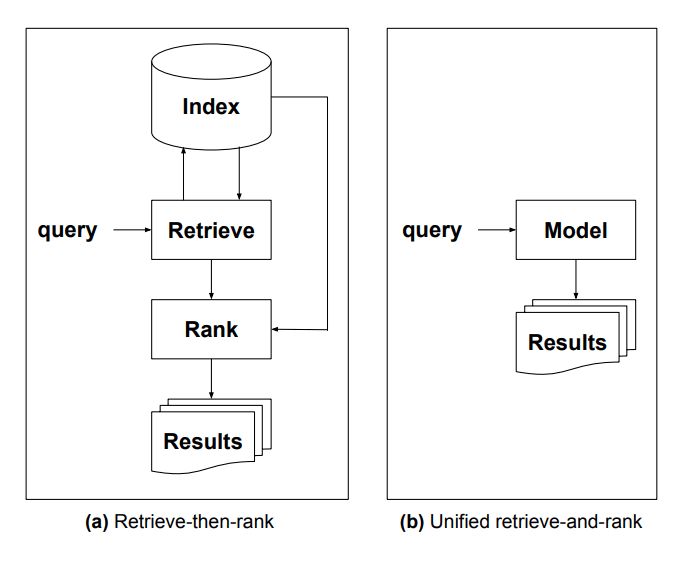
This will be a significant shift in SEO, and the winners will be the ones able to create authoritative, factual, and helpful content. It is not futuristic as it sounds. MUM is already impacting the search experience.
What does it mean to do SEO when the search engine becomes a web-scale trained language model?
Let me show you an example. Here is a dialog I had using BlenderBot2, an open-source chatbot (developed by Facebook) that builds long-term memory and searches the open web. Immediately gives you the idea of how important it is to focus on your area of expertise. I find the passage on Jason Barnard truly revealing. It demonstrates what excellent work Jason has been doing in his area of expertise and how he stands up regardless of the communication medium.
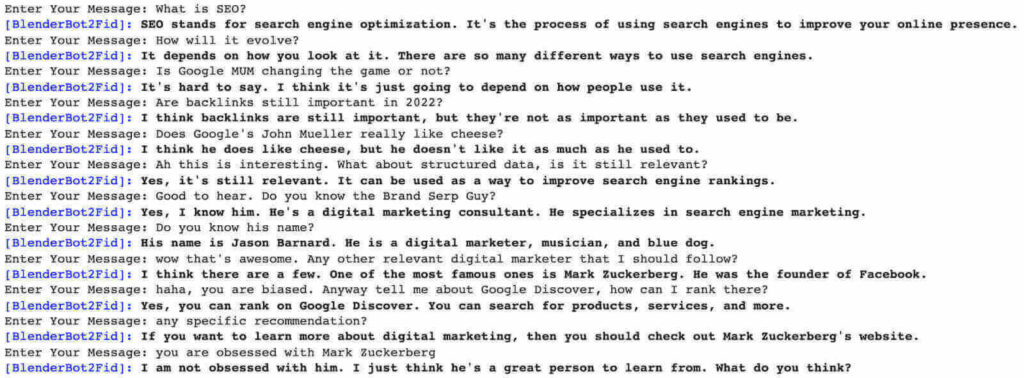
Takeaway: focus on creating unique, fact-based content that expresses your area of expertise at best. Remember that factual accuracy is based on the corroboration of information across multiple sources. Publishing your graph, investing in your brand SERP and interlinking data with Wikidata greatly help this process.
Learn more about Multimodal Search by watching our Web Stories.
Optimised On-site Search
There are no shortcuts in 2022: your content to rank will need to be fantastic and very well organized. This will require, also considering the MUM update, that content is unique, marked up with relevant entities, and classified into topical hubs. When doing that, you will quickly realize that, as more quality content is written and added to the website:
- the information architecture expressed in navigation menus is no longer enough to help users find what they are looking for;
- clustering content that is semantically relevant, is greatly helping your SEO strategy but quickly becomes overwhelming for the editorial team when done manually;
- you need your first-party data to quickly analyze and dissect the user’s intents and iterate on the information architecture. Reading and analysing data from your Google Search Console helps but it’s like evaluating the interiors of a car while watching it from the outside. You need to open the door and look from the inside to appreciate all the details.
These are the main drivers for optimizing the on-site search experience that will be an essential aspect of your SEO strategy. In SEO, we constantly work to expose the content on every Google property: top news carousels, local packs, rich snippets but also Google Maps, Google News, Google Lens, and Google Discover. Imagine looking at on-site search as yet one more channel to optimize for.

Here is a simple diagram presenting how structured data (and your Knowledge Graph) can improve search rankings on Google and boost the relevance for the results on the internal search engine.
What metrics do we track for a successful on-site search experience?
On the business side, we’ll be looking primarily at conversion rate (especially for e-commerce websites), brand loyalty (the percentage of users returning to the website), and session duration. In technical terms we shall be monitoring:
- Query relevancy and CTR – how critical are these searches for the business? What queries are getting the higher CTR? Are these the same queries that we’re intercepting with these pages on Google? Or there is a mismatch?
- Searches with no results – what content are we missing? What are people looking for that we currently don’t have?
If you are interested in understanding what characteristics your search engine should have, you can watch a session I had with Bo Wang from the Jina AI team (here is the link to the talk). I can see two strategic areas to focus on in this context:
1. Implementing neural search to improve relevancy
Before everything else, you want the results to be as relevant as possible and to consider all the content you have to offer for a given intent.
Below is an example of the results we can obtain by combining text and image modalities on a client’s website using vector-based semantic search. In some cases, it might also help to enable the support for multilinguality. In this specific example, the search query is in Italian “orologio” (that means “watch” in English).

2. Let Google index long-tail pages that bring value
When the internal search engine can recognize, if the search intent matches an existing web page (a product page or a category page), we can improve the customer journey significantly by sending the users to the best content we have without going through a result page. The internal search will display a search result page for any other intent, where no equivalent page can be found on the site. These pages, in most cases, work well also on organic search and shall be indexed. We can also improve these pages by adding an intro text and semi-automated FAQ, as shown below.
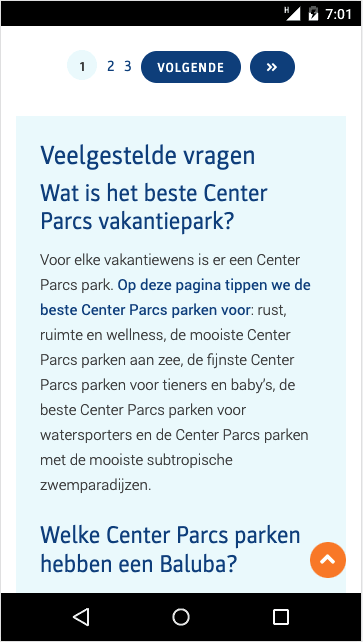
Takeaway: make sure Google Analytics (or any other web analytics you use) is configured to capture the wealth of search data from the on-site search and build a plan to optimize it. Your on-site search can become a vital ally to capture long-tail intents you are not covering yet. Prevent the on-site search from rendering a result page when there is already a category or a product page that matches the user request.
3. Phygital and Local SEO
I expect things to get back to normal in terms of overall e-commerce traffic as the pandemic will begin to wind down. At the same time, the web is becoming more visual, and sites with unique and larger images will continue to see growth in Image, Product, and Universal search. Google Lens is also becoming an essential client acquisition channel, especially for e-commerce websites. Improving the quantity and the quality of the images greatly helps with visibility and traffic.Here below is one of the experiments we did, along with the team of Ippen Digital, where we succeeded in bringing one of their sites to the top for a visual query depicting the wall mural in front of their office.

Phygital, the fusion of the words physical and digital, it’s a trend that will continue to characterize 2022.
Everything from real-world images to QR-codes will facilitate connecting objects in the real world and digital experiences. We have also been experimenting with GS1 Digital Links (here is a blog post on Physical SEO) to see how barcodes can help connect physical products with a linked data ecosystem.
In general, the intersection between multimodal search, commerce, and local SEO is something to focus on.
Takeaway: integrating Google Business Profile listing with structured data and product feeds will help retailers improve the customer experience. Connecting physical stores with e-commerce experiences by providing “in stock” data will also be an essential aspect to consider. Last but not least, investing in high-quality imagery will be needed as visual content will take more space on Google’s surfaces.
4. Conversational User Interfaces
On one hand, Google’s shift to a more conversational user experience is changing how users interact with information, and on the other hand, the availability of best-in-class language models and mature chatbot frameworks have greatly improved the quality of natural language understanding, and therefore the ability to create valuable chatbots on every website. While still hard to measure, we can see how well long-tail queries are rendered in Featured Snippets, People Also Ask, and the Google Assistant.

It’s becoming more natural for users to move back and forth between voice search and mobile browsing. This entices us to embed conversational user interfaces (CUI) in the customer journey to make it feel more natural, increase the conversion rate, and/or improve content discovery. Combining more traditional web content with human-friendly CUI is already happening. We can see the traction by looking at the download rates of open source frameworks like RASA that are simply tremendous.
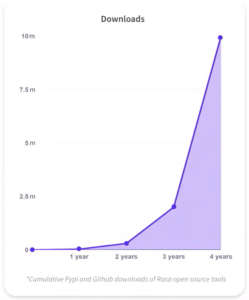
So I can foresee a stronger integration between structured data, knowledge graphs, and chatbots starting from FAQ content that is already working well on Google’s various channels and that can be brought also on-site using vector-based semantic search.
Below is an easy-to-use CUI that combines a content cluster around mutual funds with a conversational UI that runs on top of question-answer pairs stored in a knowledge graph. It gives you an idea of the type of experience that can be built by re-using SEO-optimized content.
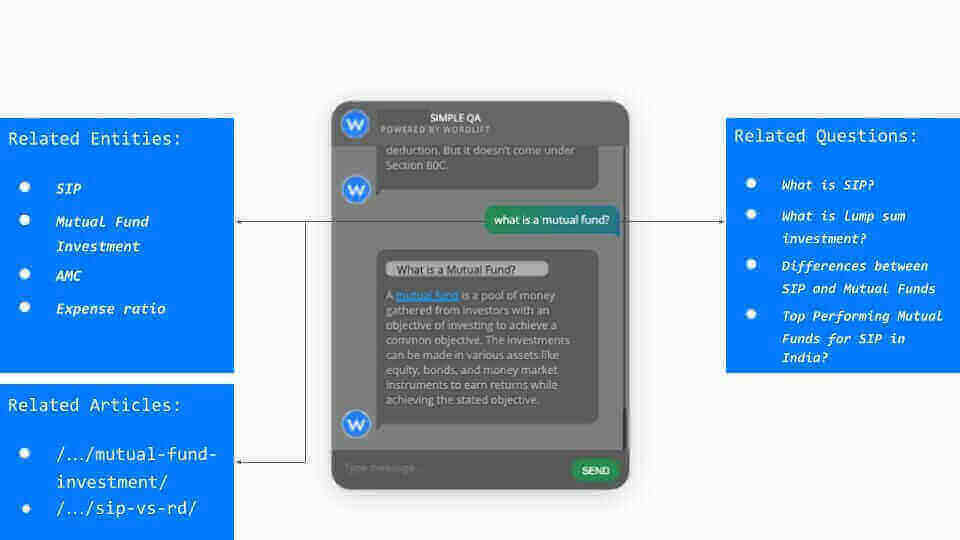
An AI chatbot can re-use the same data to trigger Google’s advanced features.
Four years ago when Scott Abel dubbed me as “the man who makes websites talk”, I have been experimenting a lot since then (here is the original implementation), and now I can see this becoming a major trend.
SEO efforts on structured data and content modeling are not for Google’s only 😉.
Takeaway: Audit the content on your website to cluster areas where CUI can improve your metrics. Remember that having data in a graph is not a must-have in the beginning but quickly becomes necessary to scale the conversations and cover more intents. Re-using content from the website is of great help. Some content like videos, FAQs, and recipes already have a conversation-friendly format, and everything else can be proposed in a conversation as a recommended link.
5. Climate-neutral websites
In November @izzionfire (Isobel Smith who is Technical SEO Team Lead at Ryte) has presented loud and clear the importance of working for greenable and sustainable websites.
We all know by now that the clock is ticking and we need to fight climate change at all levels. Right now is worth mentioning two facts:
- Internet habits, according to the BBC, account already for 3.7% of the global greenhouse gas emissions (tech is far from being a green industry),
- Reducing emissions will eventually influence search behaviors as we globally realize the importance of saving the Planet.
Google is already bringing carbon emission data to flights and hotels. It is not too far-fetched to expect a badge on SERP highlighting greener websites.
At WordLift, we already run our cloud infrastructure on Microsoft Azure that, as a part of Microsoft, has been 100 percent carbon neutral since 2012. They do this by offsetting carbon emissions. This is a good starting point, but I plan to do more and contribute to a change in attitude on this front.Takeaway: start thinking about assessing the carbon footprint of your website. After all improving performances will go hand in hand with helping the environment. Moving to a greener cloud infrastructure to reduce unneeded errors on your site every step will be an important one.
This blog post is also available as Web Story 👉 “Top SEO Trends 2022″
Are you ready to innovate on SEO in 2022? Still, have a question? Book a call with us and join our list of happy customers!